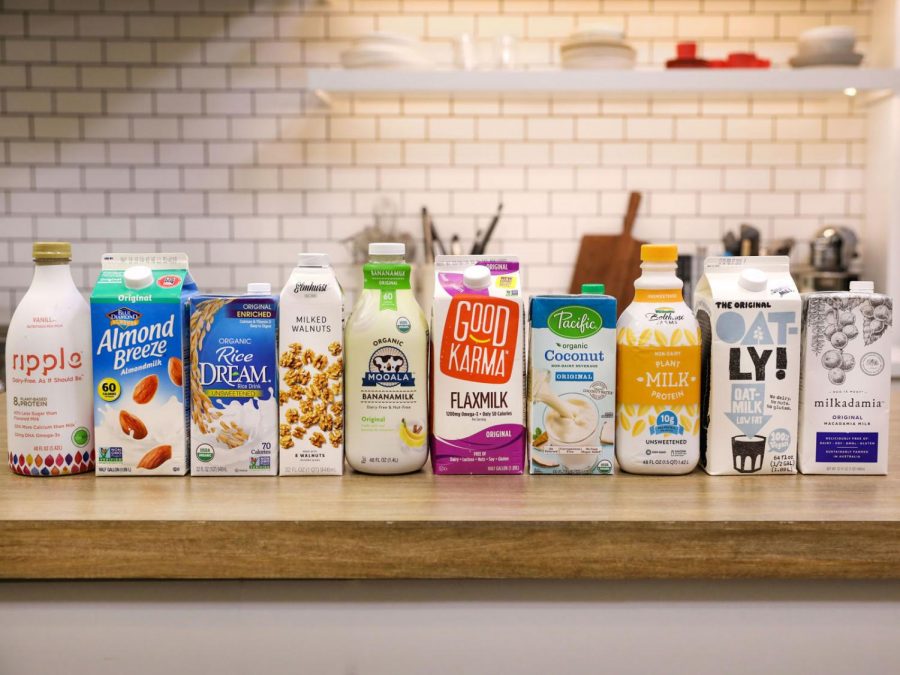The rise of alternatives to dairy
The extensive array of dairy milk alternatives allows those who can not drink milk, due to lactose intolerance, a dairy allergy, or noticed a trend with acne related to dairy, an escape from it. Those who can drink dairy milk but choose not to, do so for important reasons, such as managing cholesterol levels or avoiding diseases linked to it.
October 23, 2020
A household staple that typically accompanies breakfast cereals and everyday baking has been pushed aside for plant-based and healthier alternatives. Recently, the dairy industry has experienced hardships, such as scandals regarding the treatment of dairy cows and recent research about the negatives of dairy products for human health, as well as the ongoing global pandemic. Luckily, consumers found replacements for the product most homes consume daily.
According to Markets and Markets’ research on the dairy alternatives market, growth projection stands at 21.4 billion dollars in 2020 to 36.7 billion dollars by 2025. They attribute this massive leap to the nutritional benefits that plant-based alternatives offer. Research has linked dairy to various cancers and high cholesterol, due to the high amount of insulin-like growth factor. The calcium that milk famously provides can also exist in green, leafy vegetables.
Milk alternatives, such as almond milk, oat milk, soy milk, and cashew milk, can imitate the texture and taste of traditional milk almost perfectly, but the limit exists when it comes to price. The price of milk is relatively low, due to subsidies and a low rate of turnover tax. For milk alternatives, the price of the products fluctuate greatly and can remain steep. The popularity of these products comes from fewer calories, less fat, and a variety of vitamins and nutrients. For lactose-intolerant people, dairy alternatives remain constant in their lives, but for those that plan to focus on their health or possibly notice a trend of dairy-related acne, making the switch to dairy-free products opens up an entirely new world of brands.
Both Starbucks and Dunkin’ Donuts offer almond milk, but Starbucks’ menu also hosts coconut and soy milk. According to Forbes, oat milk will become extremely popular in 2020. Nut milk, even nuts in general, can show an expensive price tag, due to the difficulty of growing them. This could explain why oat milk gained popularity so fast due to the ease of harvesting wheat to produce the oats resulting in a lower price point. Throughout 2020, Starbucks and Dunkin’ experimented with oat milk, but Dunkin’ recently added it to the menu on August 19. Ice cream brand, Halo Top, features dairy-free options, such as birthday cake, candy bar, and chocolate almond crunch. One of the first ice cream brands to offer dairy-free flavors, they also offer keto options. Ben & Jerry’s recently followed suit and added two different options of dairy alternative to their extensive menu. They added eleven new ice cream flavors made with almond milk and three made with sunflower butter, an ingredient full of Vitamin E.
“I try my best to cut as much dairy as possible out of my life and I saw that a lot of YouTubers use almond milk or oat milk, so I decided to try it. They both taste so much better than skim milk, so now I always use them in my cereal or coffee,”senior Molly Geraci said.
Whether it be coconut milk, almond milk, oat milk, rice milk, soy milk, hemp milk, or even pea milk, dairy alternatives have taken over the coffee, ice cream, and other typical dairy product’s markets. Popular for the health benefits and the taste, alternatives allow those that can not drink milk or choose not to a way to cram in their healthy vitamins and minerals.






